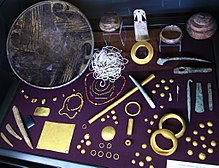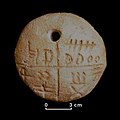Old Europe (archaeology)
| Geographical range | Mesolithic Europe |
|---|---|
| Followed by | Bronze Age Europe |

Old Europe is a term coined by the Lithuanian-American archaeologist Marija Gimbutas to describe what she perceived as a relatively homogeneous pre-Indo-European Neolithic and Copper Age culture or civilisation in Southeast Europe, centred in the Lower Danube Valley.[1][2][3] Old Europe is also referred to in some literature as the Danube civilisation.[4]
The term
The first Neolithic culture of Old Europe was Kakanj culture that appeared in Central Bosnia's town of Kakanj and covered periods dated from 6795–4900 BC.[5]
Old Europe

In 4500 bc, before the first cities were built in Mesopotamia and Egypt, Old Europe was among the most sophisticated and technologically advanced places in the world ... At its peak, about 5000–3500 bc, Old Europe was developing many of the political, technological, and ideological signs of "civilization". Some Old European villages grew to citylike sizes, larger than the earliest cities of Mesopotamia ... Old European metalsmiths were, in their day, among the most advanced metal artisans in the world, and certainly the most active. The metal artifacts recovered by archaeologists from Old Europe total about 4,700 kilograms (more than five tons) of copper, and over 6 kilograms (13.2 pounds) of gold, more metal by far than has been found in any other part of the ancient world dated before 3500 bc. The demand for copper, gold, Aegean shells, and other valuables created networks of negotiation that reached hundreds of kilometers. Pottery, figurines, and even houses were decorated with striking designs. Female "goddess" figurines, found in almost every settlement, have triggered intense debates about the ritual and political power of women. Signs inscribed on clay suggest a system of primitive notation, if not writing.
— Anthony (2010)[6]

Regardless of specific chronology, many European Neolithic groups share basic characteristics, such as living in small-scale communities, being more egalitarian[


In historical times, some
, may also have been pre-Indo-European.How many Pre-Indo-European languages existed is not known. Nor is it known whether the ancient names of peoples descended from the pre-ancient population actually referred to speakers of distinct languages. Gimbutas (1989), observing a unity of symbols marked especially on pots, but also on other objects, concluded that there may have been a single language spoken in Old Europe. She thought that decipherment would have to wait for the discovery of bilingual texts.

The idea of a Pre-Indo-European language in the region precedes Gimbutas. It went by other names, such as "
Indo-European origins
According to Gimbutas' version of the Kurgan hypothesis, Old Europe was invaded and destroyed by horse-riding pastoral nomads from the Pontic–Caspian steppe (the "Kurgan culture") who brought with them violence, patriarchy, and Indo-European languages.[12] More recent proponents of the Kurgan hypothesis agree that the cultures of Old Europe spoke pre-Indo-European languages but include a less dramatic transition, with a prolonged migration of Proto-Indo-European speakers after Old Europe's collapse due to other factors.[13][14]
Gallery
Artifacts
-
Sesklo culture figurine
-
Sesklo and Dimini culture ceramics
-
Dimini culture ceramic vessel
-
Vinča culture figurine
-
Vinča culture ceramics
-
Vinča culture, Tartaria tablet
-
Karanovo culture ceramic vessel
-
Karanovo culture ceramic vessel
-
Vadastra culture ceramic bowl
-
Tisza culture ceramic altar[20]
-
Gumelnița culture ceramic vessel
-
Gumelnița culture copper axe
-
Hamangia culture figurine
-
Hamangia culture ceramic sculpture
-
Bodrogkeresztúr culture gold idol
-
Boian culture ceramic
-
Tiszapolgár culture, copper ornaments
-
Jade pendant, Karanovo culture
-
Butmir culture ceramic vessel
-
Danilo culture ceramic vessel
-
Varna culture gold pendants
-
Petresti culture pottery
-
Cucuteni-Trypillia ceramic and copper artefacts
-
Cucuteni-Trypillia ceramics
Settlements
-
Sesklo, Sesklo culture
-
Dimini walled acropolis
-
Okoliste, Butmir culture
-
Durankulak, Varna/ Hamangia culture
-
Solnitsata, Varna culture
-
Talianki, Cucuteni-Trypillia culture
-
Village model, Cucuteni culture
-
Houses, Cucuteni-Trypillia culture
-
Maidanetske ground plan, Ukraine[21]
-
House with raised platform at Maidanetsk, c. 3700 BC
-
Magura tell site, Gumelnița culture
-
Longhouse model, Linear Pottery culture
-
Linear Pottery culture settlement
-
Neolithic house reconstructions, Karanovo culture.
See also
- Prehistoric Europe
- Early European Farmers
- Prehistory of Southeastern Europe
- Old European script
- Petrești culture
- Tell Yunatsite
- Bükk culture
- Proto-Indo-European language
- Proto-Indo-Europeans
- Indo-Iranians
- Pre-Greek substrate
- Germanic substrate hypothesis
- Goidelic substrate hypothesis
- Anatolian hypothesis
References
- ^ Jacques Leslie, The Goddess Theory: Controversial UCLA Archeologist Marija Gimbutas Argues That the World Was at Peace When God Was a Woman, Los Angeles Times, June 11, 1989.
- ISSN 0003-8113. Archived from the originalon 13 June 2022. Retrieved 4 October 2022.
- ^ Theresa Thompson, The Lost World of Old Europe: the Danube Valley, 5000-3500BC, The Ashmolean Museum, The Oxford Times, June 8, 2010.
- ISBN 9783843806466.
- ^ Vander Linden, M., Pandžić, I., Orton, D. (2022) New radiocarbon dates for the Neolithic period in Bosnia & Herzegovina. Academy of Sciences and Arts of Bosnia and Herzegovina, Godišnjak Centra za balkanološka Ispitivanja (43) 7–34 (pdf)
- ISBN 9780691143880.
- ISBN 9780691143880.
- ISBN 978-0-52025398-8. Retrieved 9 January 2015.
- ^ ISBN 9789060322888.
- ^ Paliga 1989
- .
- ^ Anthony 1995
- ^ Mallory 1991
- ^ Anthony 2007
- ^ Renfrew 1987
- ^ Renfrew 2003
- PMID 25731166.
We generated genome-wide data from 69 Europeans who lived between 8,000–3,000 years ago by enriching ancient DNA libraries for a target set of almost 400,000 polymorphisms.... This steppe ancestry persisted in all sampled central Europeans until at least 3,000 years ago, and is ubiquitous in present-day Europeans. These results provide support for a steppe origin of at least some of the Indo-European languages of Europe.
- S2CID 4399103.
- S2CID 7866359. Archived from the originalon 15 July 2022. Retrieved 4 October 2022.
- ^ "Ritual and Memory: Neolithic Era and Copper Age". Institute for the Study of the Ancient World. 2022.
- .
- S2CID 208245898.
- S2CID 259996090.
Tell Yunatsite in Bulgaria, associated with the Karanovo culture
Further reading
- Gimbutas, Marija (1991). The Civilization of the Goddess: The World of Old Europe. HarperCollins. ISBN 978-0062508041.
- Anthony, David W (2007). The horse, the wheel, and language: how Bronze-Age riders from the Eurasian steppes shaped the modern world. Princeton, NJ: Princeton University Press. ISBN 978-0-691-14818-2.
- Bailey, Douglass W. (2000). Balkan Prehistory: Exclusion, Incorporation and Identity. Routledge. ISBN 0415215986.
- Tsirtsoni, Zoï (2020). Let's stop speaking "cultures"!: Alternative means to assess historical developments in the prehistoric Balkans.
- Anthony, David (1995). "Nazi and eco-feminist prehistories: ideology and empiricism in Indo-European archaeology". Nationalism, politics, and the practice of archaeology. Cambridge: Cambridge University Press. ISBN 978-0-521-55839-6.
- Mallory, JP (1991). In search of the Indo-Europeans: language, archaeology and myth. London: Thames and Hudson. ISBN 0-500-27616-1.
- Paliga, Sorin (1989). "Proto-Indo-European, Pre-Indo-European, Old European: Archaeological Evidence and Linguistic Investigation". Journal of Indo-European Studies. 17 (3&4): 309–334. ISSN 0092-2323.
- Renfrew, Colin (1987). Archaeology and language: the puzzle of Indo-European origins. London: Jonathan Cape. ISBN 0-521-38675-6.
- Renfrew, Colin (2003). "Time Depth, Convergence Theory, and Innovation in Proto-Indo-European". Languages in Prehistoric Europe. Winter. ISBN 3-8253-1449-9.
- Bellwood, Peter (2001). "Early Agriculturalist Population Diasporas? Farming, Languages, and Genes". Annual Review of Anthropology. 30: 181–207. .
- Bellwood, Peter. (2004). First Farmers: The Origins of Agricultural Societies. Blackwell Publishers. ISBN 0-631-20566-7
- Childe, V. Gordon (1926). The Aryans: A Study of Indo-European Origins. London: Kegan Paul, Trench, Trubner.
- Gimbutas, Marija (1982). The Goddesses and Gods of Old Europe: 6500–3500 B.C.: Myths, and Cult Images Berkeley: University of California Press. ISBN 0-520-04655-2
- Gimbutas, Marija (1989). The Language of the Goddess. Harper & Row, Publishers. ISBN 0-06-250356-1.
- Gimbutas, Marija (1991). The Civilization of the Goddess. San Francisco: Harper. ISBN 0-06-250337-5.
External links
![]() Media related to Old Europe (archaeology) at Wikimedia Commons
Media related to Old Europe (archaeology) at Wikimedia Commons
- The Lost World of Old Europe: The Danube Valley, 5000-3500 BC, Institute for the Study of the Ancient World, exhibition video (2010)
- The Lost World of Old Europe: The Danube Valley, 5000-3500 BC, Museum of Cycladic Art, Athens, exhibition video, 2010
- Institute for the Study of the Ancient World : Neolithic and Copper Age
- culture.gouv.fr: Life along the Danube 6500 years ago
- Kathleen Jenks, "Old Europe": further links










![Tisza culture ceramic altar[20]](http://upload.wikimedia.org/wikipedia/commons/thumb/e/e0/Tisza1.jpg/120px-Tisza1.jpg)






















![Maidanetske ground plan, Ukraine[21]](http://upload.wikimedia.org/wikipedia/commons/thumb/4/4a/Maidanetske_ground_plan.jpg/120px-Maidanetske_ground_plan.jpg)

![Nebelivka temple, Cucuteni-Trypillia culture.[22]](http://upload.wikimedia.org/wikipedia/commons/thumb/c/c7/Nebelivka_megastructure%2C_reconstruction.jpg/120px-Nebelivka_megastructure%2C_reconstruction.jpg)
![Tell Yunatsite, Karanovo culture.[23]](http://upload.wikimedia.org/wikipedia/commons/thumb/7/75/TellYunatsite.jpg/120px-TellYunatsite.jpg)



